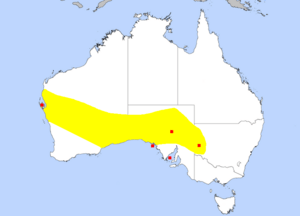Greater stick-nest rat facts for kids
Quick facts for kids Greater stick-nest rat |
|
|---|---|
 |
|
| Conservation status | |
| Scientific classification | |
| Genus: |
Leporillus
|
| Species: |
conditor
|
 |
|
The greater stick-nest rat, also known as the house-building rat or wopilkara, is a type of rodent found in Australia. These amazing animals are about the size of a small rabbit. They are famous for building large, strong nests out of sticks.
Long ago, these rats lived all over southern Australia. But after Europeans arrived, their numbers dropped a lot. For a while, they only lived on one island. Now, people are trying to help them by moving them to safe, protected areas. Some of these efforts have worked well, and some haven't.
Contents
About the Greater Stick-Nest Rat
What's in a Name?
The greater stick-nest rat was first described in 1848 by explorer Charles Sturt. At first, it was thought to be a type of mouse. Later, scientists gave it its own group, Leporillus. This name shows it's part of the Muridae family, which includes many rodents.
How to Spot One
The greater stick-nest rat has a wide, short head and big, round ears. Its body, from head to tail, is usually between 190 to 260 millimeters long. Its tail is a bit shorter, about 148 to 180 millimeters. These rats weigh between 190 and 450 grams.
Their fur is a uniform grey-brown color on top. Their belly is a lighter, buff-grey color, and these two colors blend nicely where they meet. Their feet are whitish on the inside and grey-brown on the outside.
Daily Life and Habits
Greater stick-nest rats are known for being calm and gentle animals. They are mostly active at night, which means they are nocturnal. During the day, they rest in their nests.
Their diet is mostly made up of succulent leaves, which are juicy plants. They are herbivores, meaning they only eat plants.
Amazing Nests
The most special thing about these rats is their nests! They build huge nests from sticks, often in caves, rocky areas, or around shrubs. These nests can be up to a meter (about 3 feet) tall and two meters (about 6.5 feet) wide.
The outer part of the nest is tightly woven with sticks, making it very strong. Inside, they use softer grassy materials to make a cozy space. Some rats even add small rocks to their nests to make them heavier and more secure. These strong nests help protect them from predators like dingos.
Reproduction and Life Cycle
Greater stick-nest rats can breed throughout the year. However, they are most often seen having babies during the Australian spring, which is around April and May. A mother rat usually gives birth to one to four young at a time.
Where They Live
Current Homes
Today, the greater stick-nest rat naturally lives only on the Franklin Islands in Australia. But thanks to conservation efforts, they have been moved to other safe places. These include St Peter Island, Reevesby Island, and Salutation Island. There's also a fenced area at Roxby Downs in South Australia where they live.
Scientists are also trying to reintroduce them to other areas. Some new homes include the fenced Mount Gibson Sanctuary in Western Australia and Mallee Cliffs National Park in New South Wales. They are also planned to be moved to Dirk Hartog Island and Sturt National Park.
Past and Present Habitat
In the past, these rats lived across many dry areas on the mainland. They preferred places with shallow soil and a type of rock called calcareous rock underneath. Their natural habitat is dry savanna with lots of shrubs, especially juicy plants like chenopods and pig-face.
Sadly, between 1875 and 1925, the number of many Australian mammals, including the greater stick-nest rat, dropped sharply. Scientists aren't completely sure why this happened. One idea is that a widespread disease might have affected them.
Now, greater stick-nest rats are also being bred in zoos like Monarto Safari Park and Adelaide Zoo. The babies born there are then used for the reintroduction projects to help grow their numbers in the wild.
See also
 In Spanish: Rata arquitecto para niños
In Spanish: Rata arquitecto para niños


